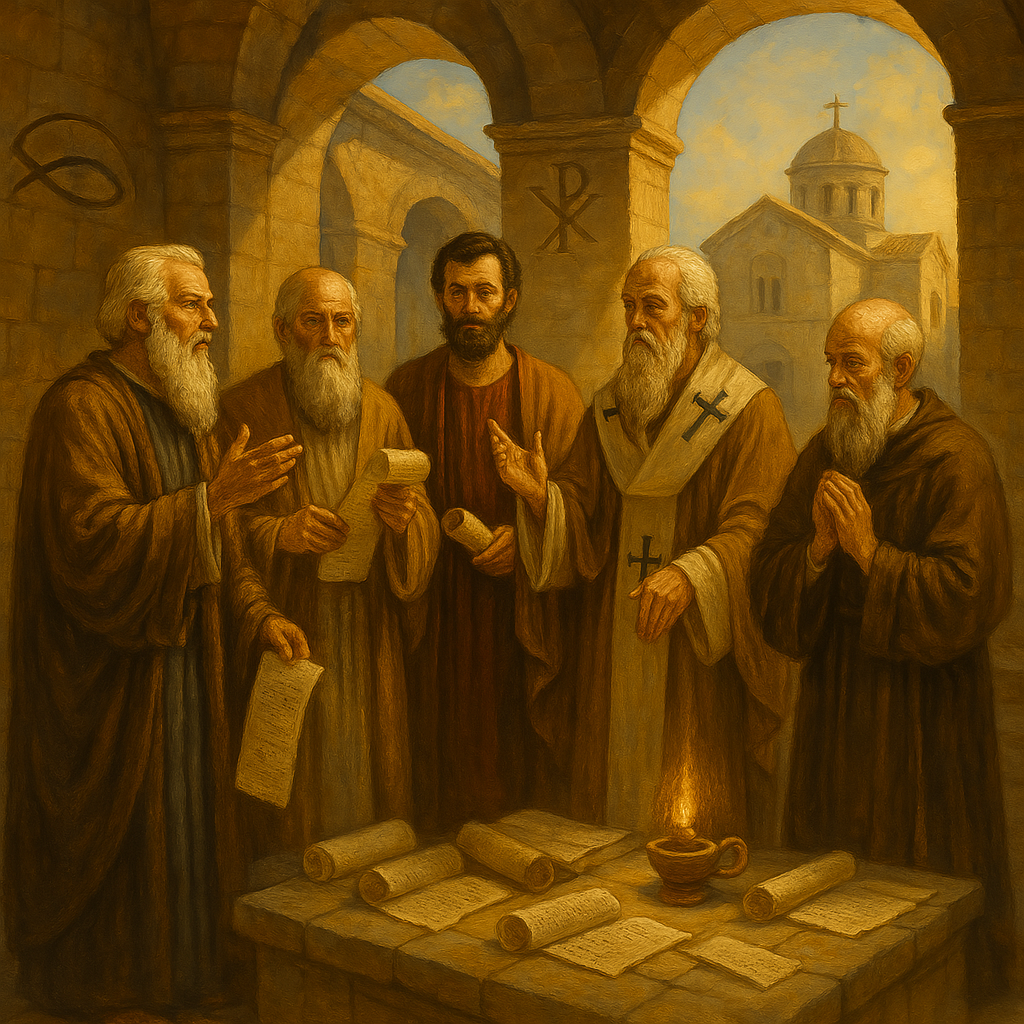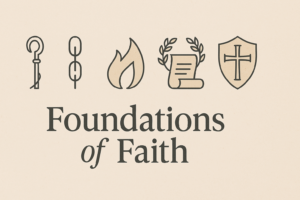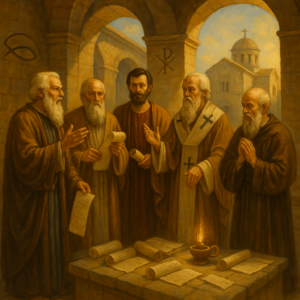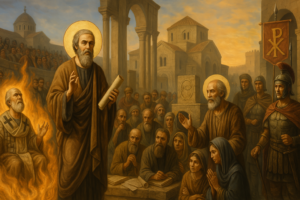Estimated reading time: 10 minutes
Key Takeaways
- The early church fathers were instrumental in shaping foundational Christian doctrines.
- Understanding their teachings can significantly transform and deepen one’s faith.
- They faced immense challenges, including persecution and theological disputes.
- Their writings provide insights into the early Christian communities and beliefs.
- The development of the Nicene Creed was a pivotal moment in Christian history.
- Key figures include St. Justin Martyr, Irenaeus, Tertullian, Origen, and Polycarp of Smyrna.
- Their legacies offer valuable lessons for modern believers seeking a profound spiritual journey.
The early church fathers were remarkable individuals who shaped Christianity as we know it today. These scholars and leaders lived during the beginning stages of the Christian faith, between the 1st and 8th centuries AD. Their teachings, writings, and leadership helped establish the core beliefs that would form the foundation of Christian doctrine for centuries to come.
Introduction to Early Church Fathers
The early church fathers were pioneering theologians who faced tremendous challenges as they worked to clarify, defend, and spread Christian teachings in a world often hostile to their faith. From Roman persecution to internal theological debates, they navigated complex issues while preserving what they believed was the authentic message of Christ and his apostles.
One of the most significant contributions of these early leaders was the development of the Nicene Creed, a statement of faith that represents the collective wisdom and theological understanding of the early Christian church. This creed emerged as these church fathers combated various heresies and worked to establish clear theological concepts that remain paramount to Christian history.
The influence of these early Christian thinkers extends far beyond their own time, providing us with valuable spiritual lessons that can transform our faith even today. Their courage, wisdom, and devotion offer insights that remain relevant and powerful for modern believers.
Early Church Fathers History and Context
Understanding the early church fathers history requires us to look at the world they inhabited. These influential Christian thinkers lived during a time of significant transition and challenges for the emerging Christian faith.
The earliest church fathers, often called the Apostolic Fathers, lived between 70-150 AD. They had direct connections to the apostles themselves. This period was marked by intense Roman persecution and the need to establish Christian communities in a hostile environment.
Following them came the Ante-Nicene Fathers (150-325 AD), who confronted various heresies and worked to clarify Christian doctrine. They operated during a time when Christianity was still illegal but growing rapidly throughout the Roman Empire.
The Post-Nicene Fathers (325-451 AD) worked in a dramatically different context after Constantine’s conversion made Christianity legal. Their focus shifted to refining theological concepts and church organization as Christianity became more established.
These early leaders faced numerous challenges:
- Intense persecution under various Roman emperors
- The need to define Christian beliefs against competing religious ideas
- Internal disagreements about key theological concepts
- Establishing church authority and organization
- Preserving accurate teaching while Christianity spread to new regions
The writings of the apostolic fathers provide unique insights into the earliest Christian communities. Leaders like Clement of Rome, Ignatius of Antioch, and Polycarp of Smyrna focused on practical matters of church life, unity, and faithfulness to apostolic teaching. Their letters and instructions offer a glimpse into how the very first generations of Christians understood their faith.
In contrast, the Patristic fathers (later church fathers) dealt with more complex theological questions and systematic formulations of Christian doctrine. They built upon the foundations laid by the apostolic fathers, developing more detailed explanations of Christian beliefs about God, Christ, salvation, and the church.
St. Justin Martyr Teachings on Apologetics
St. Justin Martyr stands as one of the most influential early defenders of the Christian faith. Born around 100 AD in Samaria (modern-day Palestine), Justin was a philosopher who searched for truth through various philosophical schools before encountering Christianity. What makes his story so compelling is that he was an educated pagan who came to believe that Christianity was the true philosophy he had been seeking all along.
The Justin Martyr writings represent some of the earliest and most important Christian apologetic works. As a trained philosopher, Justin used his intellectual skills to defend Christianity against both Jewish criticisms and Roman persecution. His approach to defending the faith included:
- Using reason and philosophy to explain Christian beliefs
- Drawing parallels between Christian teachings and respected philosophical concepts
- Addressing common misconceptions about Christian practices
- Appealing to fulfilled prophecies as evidence of Christianity’s truth
- Explaining how Christian teachings led to moral transformation
His two most famous works, “First Apology” and “Second Apology,” were addressed to Roman emperors, defending Christians against false accusations and arguing for fair treatment. In these documents, Justin provided some of our earliest descriptions of Christian worship practices, including baptism and the Eucharist.
Justin also wrote “Dialogue with Trypho,” a record of his conversation with a Jewish scholar. This work shows how early Christians understood the relationship between Christianity and Judaism, particularly how they interpreted the Old Testament.
What makes Justin especially remarkable is his courage in defending his faith. He didn’t just write about Christianity—he lived it boldly, even knowing the risks. True to his title “Martyr,” Justin was beheaded in Rome around 165 AD for refusing to sacrifice to the Roman gods. His final testimony before his execution demonstrates the sincerity and conviction that characterized his life and writings.
Irenaeus Writings Against Heresies
Irenaeus of Lyons emerged as a powerful voice for orthodox Christianity during a time when various alternative interpretations of the faith were gaining popularity. Born around 130 AD in Smyrna (modern-day Turkey), Irenaeus had studied under Polycarp, who himself had been a disciple of the Apostle John. This connection to the apostolic generation gave Irenaeus special authority when addressing what constituted authentic Christian teaching.
The Irenaeus writings cover various theological topics, but he is best known for his masterwork “Against Heresies” (also called “Detection and Overthrow of False Knowledge”). This five-volume work represents one of the most significant early defenses of orthodox Christianity against alternative teachings that were spreading in the second century.
In “Irenaeus against heresies,” he primarily combated Gnosticism, a collection of religious ideas that claimed:
- Secret spiritual knowledge (gnosis) was necessary for salvation
- The material world was evil, created by a lesser god or demiurge, not the true God
- Jesus was not truly human but only appeared to be (docetism)
- A sharp division existed between spiritual and physical reality
Irenaeus methodically dismantled these claims by:
- Emphasizing the unity of God as both creator and redeemer
- Affirming the goodness of creation and the physical world
- Defending the full humanity and divinity of Jesus Christ
- Stressing the public, historical nature of Christian teaching versus secret knowledge
- Establishing the authority of the four Gospels and apostolic teaching
What makes Irenaeus particularly valuable for students of church history is that he carefully explained the positions he was arguing against. This provides us with detailed information about early alternative Christian movements that might otherwise be lost to history.
Irenaeus also contributed significantly to developing the concept of apostolic succession—the idea that true Christian teaching was passed down through a line of bishops starting with the apostles themselves. He compiled one of the earliest lists of Roman bishops, tracing their lineage back to Peter and Paul.
Tertullian and Origen Theological Contributions
Tertullian and Origen represent two of the most brilliant and complex minds of the early Christian era. Though dramatically different in their approaches to theology, both men made lasting contributions that continue to influence Christian thought.
Tertullian (c. 155-220 AD), born in Carthage (modern Tunisia), was the first major Christian writer to produce a substantial body of work in Latin rather than Greek. Trained as a lawyer, he brought a precise, logical approach to theological questions. His contributions include:
- Coining pivotal theological terms still used today, including “Trinity,” “person,” and “substance”
- Developing early versions of the doctrine of original sin
- Crafting powerful defenses of Christianity against pagan criticisms
- Formulating precise language about Christ’s divine and human natures
Origen (c. 185-254 AD) took a dramatically different approach. Based in Alexandria, Egypt, Origen embraced philosophical thinking and allegorical interpretation of scripture. His contributions include:
- Developing a comprehensive system of biblical interpretation
- Creating the “Hexapla,” an enormous work comparing six versions of the Old Testament
- Writing one of the first systematic presentations of Christian theology in “On First Principles”
- Advancing ideas about universal salvation and the pre-existence of souls
These two thinkers represent different approaches to Christianity that would continue throughout church history:
- Tertullian emphasized clear boundaries, precise definitions, and practical moral discipline
- Origen explored speculative theology, mystical interpretations, and philosophical integration
Despite their differences, both men were committed to defending and explaining the Christian faith during a crucial period of its development. Their works provide valuable insights into how early Christians understood their scriptures, traditions, and relationship to the surrounding culture.
Polycarp of Smyrna Writings and Martyrdom
Polycarp of Smyrna stands as one of the most direct connections between the apostolic age and later Christianity. Born around 69 AD, Polycarp was a disciple of the Apostle John and served as bishop of Smyrna (modern-day Izmir, Turkey) for decades. His long life bridged the gap between the first Christians who knew Jesus personally and the emerging church of the second century.
The Polycarp of Smyrna writings that survive are limited but significant. His “Epistle to the Philippians” provides important insights into early Christian beliefs and practices. In this letter, Polycarp:
- Emphasizes practical Christian living and moral conduct
- Quotes extensively from the New Testament, showing how early Christians used these writings
- Warns against false teachers who denied Christ’s incarnation and resurrection
- Encourages believers to follow the example of Christ in humility and patient suffering
Unlike many church fathers who wrote extensively, Polycarp’s influence came more through his exemplary life and leadership than through his writings. He was known for his faithfulness to apostolic teaching and his firm stand against early heresies.
Polycarp’s greatest testimony came through his martyrdom in approximately 155 AD, when he was around 86 years old. The account of his death, recorded in “The Martyrdom of Polycarp,” is one of the earliest and most moving martyrdom accounts outside the New Testament. This document reveals:
- Polycarp’s calm dignity when arrested
- His refusal to renounce Christ despite being threatened with wild animals and fire
- His famous response when commanded to reject Christ: “Eighty-six years have I served him, and he has done me no wrong. How can I blaspheme my King who saved me?”
- His prayer of thanksgiving even as he was being executed
The manner of Polycarp’s death made a profound impression on the Christian community. Rather than undermining the faith, his martyrdom strengthened the church’s resolve and provided a powerful example of faithfulness to the end.
Church Fathers from Clement of Rome to Augustine
The period from Clement of Rome to Augustine spans over three centuries of remarkable Christian thinkers who shaped the development of early Christianity. This chronological overview helps us understand how Christian thought developed through different challenges and contexts.
Clement of Rome (c. 35-99 AD) is considered the first Apostolic Father. As bishop of Rome, he wrote an epistle to the Corinthian church around 96 AD that emphasized church unity and proper order. His letter shows how early Christian communities functioned and communicated with one another.
Ignatius of Antioch (c. 35-108 AD) wrote seven authentic letters while being transported to Rome for execution. These letters emphasized church unity, the authority of bishops, and the real humanity and divinity of Christ. His writings show early development of church hierarchy.
Clement of Alexandria (c. 150-215 AD) sought to bridge Christianity with Greek philosophy. As head of the catechetical school in Alexandria, he emphasized how Christian faith could fulfill the highest aspirations of Greek thought.
Cyprian of Carthage (c. 200-258 AD) focused on church unity and the role of bishops. During intense persecution and controversy over reinstating Christians who had renounced their faith, Cyprian developed important ideas about church authority and forgiveness.
Athanasius of Alexandria (c. 296-373 AD) was the chief defender of the Nicene understanding of Christ’s full divinity. Though exiled multiple times, his persistent defense of orthodox Christology eventually prevailed. His statement that “God became man so that man might become God” captures his understanding of salvation.
The Cappadocian Fathers – Basil the Great (330-379), Gregory of Nyssa (c. 335-395), and Gregory of Nazianzus (329-390) – refined Trinitarian theology, explaining how God could be both three and one. Their work was crucial for establishing orthodox understanding of the Trinity.
John Chrysostom (c. 347-407), known as “Golden-mouthed” for his preaching ability, served as Archbishop of Constantinople. His sermons emphasized practical application of scripture and social justice.
Augustine of Hippo (354-430) represents the culmination of Western patristic thought. His voluminous writings addressed philosophy, theology, scriptural interpretation, and church practice. Key contributions include:
- Developing the doctrine of original sin
- Articulating a comprehensive understanding of divine grace
- Composing “The City of God,” explaining Christianity’s relationship to society
- Writing “Confessions,” the first Western spiritual autobiography
Saint Ignatius of Antioch and Church Hierarchy
Saint Ignatius of Antioch stands as one of the most important witnesses to early church structure and belief. Born around 35 AD, Ignatius served as the third bishop of Antioch in Syria, a major center of early Christianity. His legacy comes primarily through seven authentic letters he wrote while being transported to Rome for execution around 108 AD.
The Ignatius of Antioch writings provide a crucial window into how church organization was developing in the early second century. His letters were addressed to Christian communities in Ephesus, Magnesia, Tralles, Rome, Philadelphia, and Smyrna, plus a personal letter to Polycarp. Through these correspondences, we can trace several important developments:
Ignatius strongly emphasized a three-tier leadership structure:
- One bishop who had primary authority in each local church
- A council of elders (presbyters) who assisted the bishop
- Deacons who served practical needs of the community
His famous instruction was: “Do nothing without the bishop.” This represents one of the earliest clear articulations of episcopal authority in church governance.
Beyond church organization, Ignatius’s letters reveal other important aspects of early Christian belief:
- Vigorous defense of Christ’s full humanity against docetic claims that Jesus only appeared to be human
- Emphasis on the real presence of Christ in the Eucharist
- Strong calls for church unity centered around the bishop
- Warning against Judaizing tendencies and false teachings
Formation of Christian Doctrine Through Early Fathers
The formation of Christian doctrine was a gradual process guided by the early church fathers as they applied scripture, reason, and tradition to the questions and challenges of their time. This development wasn’t the invention of new ideas but the clarification and articulation of beliefs already present in the apostolic teaching.
Several factors drove this doctrinal development:
- The need to explain Christian beliefs to non-Christian audiences
- Challenges from alternative interpretations of Christianity
- Questions arising from cultural contexts as the faith spread
- Practical issues in church life requiring theological solutions
Key theological concepts that took shape during this period include:
Early Church Fathers on the Trinity
The doctrine of the Trinity—that God exists as Father, Son, and Holy Spirit, three persons in one divine essence—is central to Christian theology. The early church fathers on the Trinity played a crucial role in developing this understanding, moving from implicit biblical teachings to explicit theological formulations.
The path to Trinitarian doctrine wasn’t straightforward. Early Christians knew from scripture that:
- There is one God (monotheism)
- Jesus Christ is divine
- The Holy Spirit is divine
- Yet these three are somehow distinct
Articulating how these truths fit together required centuries of careful theological reflection. Key developments included:
- Pre-Nicene Understanding (Before 325 AD):
- Justin Martyr described the Son as “another God” while maintaining monotheism, showing the early struggle to find precise language
- Tertullian first used the Latin term “trinitas” (trinity) and developed the language of “one substance, three persons”
- Origen explored the eternal relationship between Father and Son, though some of his formulations were later questioned
- Nicene and Post-Nicene Development (325-381 AD):
- The Council of Nicaea (325 AD) affirmed that the Son is “of the same substance” (homoousios) as the Father, rejecting Arian claims that the Son was created
- Athanasius vigorously defended the Nicene position, emphasizing the full divinity of the Son
- The Cappadocian Fathers clarified the distinctions between Father, Son, and Holy Spirit while maintaining unity
- The Council of Constantinople (381 AD) expanded on Nicaea, solidifying the doctrine of the Trinity
These developments were not merely academic but were driven by intense debates about the nature of God and salvation. The early church fathers sought to preserve the mystery of God’s nature while providing language that accurately reflected scriptural teachings.
The resulting doctrine of the Trinity remains a central tenet of mainstream Christian theology, reflecting centuries of contemplation and spiritual insight.
Frequently Asked Questions
- Why are the early church fathers important to Christianity?
The early church fathers are crucial because they helped shape the foundational doctrines of Christianity. Their writings, teachings, and leadership established core beliefs and practices that continue to influence Christian faith and theology today.
- What challenges did the early church fathers face?
They faced intense persecution from Roman authorities, internal theological disputes, and the need to define Christian beliefs against competing religious ideas. They also worked to establish church authority and preserve accurate teachings as Christianity spread.
- How did the early church fathers contribute to the formation of the Bible?
They played a role in recognizing and affirming the canonical books of the New Testament. Through their citations, teachings, and discussions, they helped the early church discern which writings were genuinely apostolic and inspired.
- What can modern Christians learn from the early church fathers?
Modern Christians can learn about steadfast faith, the importance of sound doctrine, the value of unity, and how to engage thoughtfully with cultural challenges. Their lives exemplify courage, wisdom, and devotion that can inspire and transform personal faith journeys.




